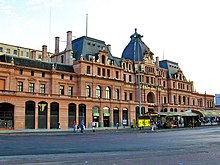Ferrocarril del Sud
The Ferrocarril del Sud was one of the "Big Four" railway companies in British possession, in Argentina route networks in Indian broad gauge built and operated. The company was founded in 1862 by Edward Lumb as the Buenos Aires Great Southern Railway (BAGS) . Its first general manager was Edward Banfield , after whom the Banfield station (opened in 1873) and the southern suburb of Buenos Aires that grew around this station are named. With the nationalization of the railways in Argentina by President Juan Perón in 1948, Ferrocarril del Sud became part of Ferrocarril General Roca .
history
With a celebration on March 7, 1864, which was also attended by President Bartolomé Miter , construction work began on the site of today's terminus at Plaza Constitución in Buenos Aires, and in 1865 the 114 km long route to Chascomús was completed. The Plaza Constitución train station has been rebuilt and expanded several times. On September 19, 1925, the Prince of Wales laid the foundation stone for today's reception building during his official visit to Argentina.
growth
By 1930 the company had grown into a huge corporation, possibly the largest of its kind in the southern hemisphere . It had more than 8,000 km of single-track lines, mostly in broad gauge, 504 stations, 857 steam locomotives, 955 passenger cars, 16,602 freight cars and employed more than 30,000 people. Their influence on the life and development of the Province of Buenos Aires was considerable. The route network was designed to serve traffic between cities within the province and the capital, and to transport domestic agricultural products, many of which were intended for export, to the ports of Buenos Aires, Necochea and Bahía Blanca .
Additional facilities
The company and its subsidiaries owned and operated numerous ancillary facilities. This included facilities for grain handling, a test farm in Cinco Saltos in the Rio Negro Valley, a power plant in Bahía Blanca, the Argentine Fruit Distributors Company , the FCS agricultural field railways, a long-distance bus company and several hotels (one with a golf course).
Ports
One of the ports in Bahía Blanca, Puerto Ingeniero White , was built by the railway company, who installed two grain elevators there in 1908 to handle the increasing grain transport and built a pier for four steamers. Together with the other British-owned railway companies, it was involved in the Compañía Ferrocarriles de Petróleo in Comodoro Rivadavia , whose sources supplied a large part of the heating oil for the locomotives of these railway companies. She also operated the South Dock in Buenos Aires at the mouth of the Riachuelo .
traffic
A large part of the freight traffic, including the transport of grain and cattle as well as fruit from the valley of the Río Negro , was just as seasonal as the summer holiday traffic to Mar del Plata , Miramar and Necochea. In addition to the suburban traffic around Buenos Aires and Bahía Blanca, the greatest volume of traffic was accounted for by the connection between these two cities via three different routes: the direct route via Las Flores , Olavarría and Coronel Pringles with the branch route from Olavarría via General La Madrid and Saavedra and the Branch line from Las Flores via Tres Arroyos. Passenger traffic beyond Bahía Blanca - to Zapala in the province of Neuquén and to Bariloche in the province of Río Negro - was initially served by through coaches that were set on trains to Bahía Blanca, but soon grew so strongly that additional through trains from Buenos Aires were required.
Extensions
A 1906 planned extension of the line from Zapala, 115 km from the Chilean border, across the Andes to Lonquimay in Chile failed due to a lack of capital. This would have been a second railway connection between the two countries, in addition to the Transand Railway opened in 1910 between Mendoza in Argentina and Los Andes in Chile.
Other main routes ran from Buenos Aires via Bolívar to Carhué, via Maipú to Tandil , via Parque Chas and Ayacucho to Necochea and from Bahía Blanca to Toay in the province of La Pampa and to Huinca Renanco in the province of Córdoba .
Locomotives
Except during World War II , most steam locomotives - almost all of them British-made - were heated by oil, as Argentina was almost self-sufficient in terms of this raw material. Suitable locomotive coal does not exist in the country and had to be imported. The heaviest freight trains, which could reach over 2000 tons during the harvest season , were often pulled by Garratt locomotives .
workshops
The main workshop of the railway company was built in 1901 in Remedios de Escalada , 11 km from the Plaza Constitución. It was the largest in South America and employed almost 3,000 people. Although mainly repairs were carried out, every part of a locomotive or wagon could be made here. Another workshop in Bahía Blanca was added in 1925 with the takeover of the Bahía Blanca and North Western Railway .
Road traffic competition
In 1930 the company was at the height of its prosperity, but towards the end of that year the negative effects of the increasing devaluation of the Argentine peso began to be felt and labor costs rose significantly. In addition, society was faced with increasing competition from traffic on the expanding road network.
Individual evidence
- ↑ Attempts to cross the border ( English ) Railways of the far south. July 29, 2012. Retrieved March 4, 2013.
literature
- DSPurdom, British Steam on the Pampas , Mechanical Engineering Publications Ltd, London, 1977.
- William Rogind, Historia del Ferrocarril Sud 1861-1936, Edit. Ferrocarril Sud, Buenos Aires, 1937.
- Colin M. Lewis, British Railways in Argentina 1857–1914: A Case Study of Foreign Investment , Athlone Press (for the Institute of Latin American Studies, University of London), 1983.

